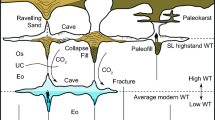Abstract
Scan electron micrographs (SEMs), are shown of three representative types of Georgia kaolin: ‘soft’, Cretaceous-age clay; ‘hard’, fine-grained clay; and ‘flint kaolin’.
Sparta Granite and a thick deposit of its overlying saprolite are taken to serve as examples of probable source rock for Georgia kaolin. SEMs are presented to show sequential argillation of this fresh granite through a transition zone to the saprolite. The saprolite contains abundant books of kaolinite similar to those occurring in Cretaceous kaolin, accompanied by some elongates, whereas in the transition zone elongates are predominant. A morphologic type of fibrous, elongate 1:1 clay mineral, hitherto not illustrated, is shown from kaolinizing Sparta Granite, and from Pre-Cambrian saprolitic gneiss 25 km south of Athens, GA.
Whereas kaolin elongates originated in contact with feldspar in the Sparta transition zone, well-formed books of kaolinite are shown to have been formed in contact with feldspar in the saprolite from a Missouri granite. The arkose above the granite in the Missouri occurrence has altered to loosely packed books of kaolinite. The interpretation is made that book-type kaolinite, where it occurs in large deposits of saprolite or kaolin, was formed under geochemical conditions of relative chemical stability between kaolinite and feldspar, as might prevail in a geological ‘weathering crust’. It is interpreted that elongate kaolin morphology may be formed under conditions of limited or lesser geochemical stability.
SEMs show that the established book-morphology of Sparta saprolite is disarranged during secondary Holocene surface weathering and pedogenic processing.
SEMs show that books of kaolinite, although individually fragile, may be protected from destruction or delamination during artificial blunging and transport when moved within naturally coalesced pellets. Possibly original books of weathered kaolinite might similarly survive natural stream transport during sedimentational processes.
Some ‘flint kaolin’ contains molds of sponge spicules coated with low-cristobalite.
Similar content being viewed by others
References
API, Amer. Petrol. Inst., Project 49 (1949) Reference Clay Minerals, Prelim. Rep., 1–8, Paul F. Kerr and others, Columbia University.
Austin, R. S. (1976) The origin of Georgia’s kaolin deposits: preprint: 1976 Forum Geology of Industrial Minerals, Atlanta, GA; Geologic and Water Division, 17 pp. Georgia Dept of Natural Resources.
Baumann, D. and Keller, W. D. (1975) Bulk densities of selected dried natural and fired kaolin clays: Clays and Clay Minerals 23, 424–427.
Blaxland, A. B. (1974) Geochemistry and geochronology of chemical weathering, Butler Hill Granite, Missouri: Geochim. Cosmochim. Acta 38, 843–852.
Grim, R. E. and Wahl, F. M. (1968) Kaolin deposits of Georgia and South Carolina, U.S.A.: XXIII Int. Geol. Cong., Vol. 14, 9021.
Hinckley, D. N. (1961) Mineralogical and chemical variations in the Coastal Plain of Georgia and South Carolina: Ph.D. Thesis, Penna State University, 194 pp.
Jonas, E. C. (1964) Petrology of the Dry Branch, Georgia, kaolin deposits: Proc. 12th Natl Clay Conf., Clays and Clay Minerals, 199–205.
Keller, E. D. (1963) Hydrothermal kaolinization (endellitization) of volcanic glassy rock: 10th Natl Conf. Clays and Clay Minerals, pp. 333–343. Pergamon Press, Oxford.
Keller, W. D. (1976) Scan electron micrographs of kaolins collected from diverse origins, Parts I, II, III, V: Clays and Clay Minerals 24, 107–113, 114–117, 262–264; 25,
Keller, W. D. and Hanson, R. F. (1975) Dissimilar fabrics by scan electron microscopy of sedimentary versus hydrothermal kaolins in Mexico: Clays and Clay Minerals 23, 201–204.
Kesler, T. L. (1963) Environment and origin of the Cretaceous kaolin deposits of Georgia and South Carolina: Georgia Mineral Newsletter 18 (1–2), 3–11.
Kesler, T. L. (1956) Environment and origin of the Cretaceous kaolin deposits of Georgia and South Carolina: Econ. Geol. 51, 541–554.
Klinefelter, T. A., O’Meara, R. G., Truesdell, G. C. and Gottlieb, S. (1943) Hard and soft kaolins of Georgia: U.S. Bur. Mines, Rep. Invest. 3682, 20 pp.
Meunier, A. and Velde, B. (1976) Mineral reactions at grain contacts in early stages of weathering: Clay Minerals 11, 235–240.
Murata, K. J. and Larson, R. R. (1975) Diagenesis of Miocene siliceous shales, Temblar Range, California: J. Res. U.S. Geol. Survey 3, 553–566.
Murray, H. H. (1976) The Georgia sedimentary kaolins: 7th Symp. Genesis of Kaolin, Int. Geol. Correlation Program, Committee on Correlation of Age and Genesis of Kaolin, Tokyo, pp. 114–125.
Parham, W. E. (1969) Formation of halloysite from feldspar: low temperature, artificial weathering versus natural weathering: Clays and Clay Minerals 17, 13–22.
Patterson, S. H. and Buie, B. F. (1974) Field conference on kaolin and fuller’s earth, Nov. 14–16, 1974: Guidebook 14, Geo. Geol. Surv. and Soc. Econ. Geol., 53 pp.
Patterson, S. H. and Murray, H. (1975) Clays: Industrial Minerals and Rocks (Nonmetallics other than Fuels), 4th edition, pp. 519–585. AIMMPE, New York.
Reesman, A. L. (1966) A study of clay mineral dissolution: Ph.D. dissertation, University of Mo.–Columbia.
Reesman, A. L. and Keller, W. D. (1968) Aqueous solubility studies of high-alumina and clay minerals: Am. Miner. 53, 929–942.
Smith, R. W. (1929) Sedimentary kaolins of the Coastal Plain of Georgia: Georgia Geol. Surv. Bull. 44, 474 pp.
Wada, K., Henmi, T., Yoshinaga, N. and Patterson, S. H. (1972) Imogolite and allophane formed in saprolite on Maui, Hawaii: Clays and Clay Minerals 20, 375–380.
Author information
Authors and Affiliations
Rights and permissions
About this article
Cite this article
Keller, W.D. Scan Electron Micrographs of Kaolins Collected from Diverse Environments of Origin—IV. Georgia Kaolin and Kaolinizing Source Rocks. Clays Clay Miner. 25, 311–345 (1977). https://doi.org/10.1346/CCMN.1977.0250501
Received:
Accepted:
Published:
Issue Date:
DOI: https://doi.org/10.1346/CCMN.1977.0250501




